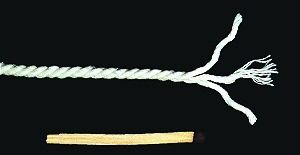Sewing threads are usually used as a connecting material in the manufacture of clothing, shoes, interior decoration, toys and other necessary things. At the dawn of mankind, the role of threads was played by the veins of hunted animals and plant stems. Read on to find out what they are made of.
Structure and properties of sewing thread
 Sewing thread is a thin yarn, thin and long, evenly twisted. Obtained from fibers of natural or artificial origin. Used for joining cut fabric parts.
Sewing thread is a thin yarn, thin and long, evenly twisted. Obtained from fibers of natural or artificial origin. Used for joining cut fabric parts.
The structure may have differences in thickness, direction of twist, number of folds, fiber composition. Thickness is usually indicated by a number; cotton ones can have No. 10 or more, silk ones - 18,33, 65. For natural ones, it is typical: the higher the number, the thicker the thread. For synthetic ones it’s the other way around. The direction of twist is right and left, the first is more reliable.
Important! The sewing material must be at least double-twisted - made by twisting two original threads.The number of folds also affects strength; threads are made in 2, 6, 9, 12 folds.
Threads come in different qualities, so when choosing, you should pay attention to the following:
- tensile strength - it’s difficult to tear it with your hands;
- smoothness is an important quality for use in sewing machines, so that it does not get stuck in the needle, breaking the eye at the wrong moment;
- uniform twisting (the absence of thickenings makes the connecting material invisible);
- resistance to high temperatures, water, detergents - will not fade, deform or shrink the seams;
- lint particles, if any, indicate poor quality.
Types of thread compositions
Its use depends on the composition of the sewing material. There is no universal option suitable for any fabric. There are three groups of threads based on their composition.
Synthetic
 They are made from polymer raw materials, which in molten form are pressed through holes of the required dimensions, resulting in fibers of a given length and thickness. It is difficult to distinguish them from natural threads by appearance, but they are cheaper and have the necessary qualities: stretchability, strength, and water resistance. One There is still a drawback - low heat resistance. There are:
They are made from polymer raw materials, which in molten form are pressed through holes of the required dimensions, resulting in fibers of a given length and thickness. It is difficult to distinguish them from natural threads by appearance, but they are cheaper and have the necessary qualities: stretchability, strength, and water resistance. One There is still a drawback - low heat resistance. There are:
- Staple. Synthetic threads are very similar to cotton threads; they are more durable and do not shrink. They are used for sewing linen, shirts, silk fabrics and even leather.
- Monofilament is a transparent thread made from polyamide. It is elastic, resistant to abrasion, and when treated with optical substances it can acquire the color of the fabric being joined. Suitable for light-colored products.
The most the best artificial threads for sewing are those that are marked LL. They combine a polyester fiber core with a Mylar braid. This is one of the types of reinforced threads that are the strongest of all.
Natural
 Cotton – indispensable when sewing clothes, especially for children. Suitable for any sewing process - from basting to securing seams. Cotton is a plant grown for the textile industry. It is collected and combed, obtaining fibers of about 6 cm. In the spinning shop, cotton yarn is twisted into threads in several layers.
Cotton – indispensable when sewing clothes, especially for children. Suitable for any sewing process - from basting to securing seams. Cotton is a plant grown for the textile industry. It is collected and combed, obtaining fibers of about 6 cm. In the spinning shop, cotton yarn is twisted into threads in several layers.
Linen threads are made from flax; they are found infrequently in shoe production and in the manufacture of lace. Viscose ones are made from wood, but they are inferior in strength to other varieties. Silk is obtained from the cocoons of the silkworm by unwinding the fibers of the pupae of this insect. Such threads are usually used to make finishing seams.
Mixed composition
 Currently, 100% natural sewing threads are rarely used. Combined compositions have the best properties of sewing materials, therefore more popular. We are talking about reinforced threads, the strongest existing options.
Currently, 100% natural sewing threads are rarely used. Combined compositions have the best properties of sewing materials, therefore more popular. We are talking about reinforced threads, the strongest existing options.
Reinforcement – strengthening of the thread by combining fibers that increase each other’s strength. The central part of such a thread is usually synthetic (polyester) and provides tensile strength. The braid can be cotton, polyester, or siblon. It gives the necessary smoothness. The result is strong, wear-resistant, shrink-free, heat-resistant and elastic threads. Withstands any number of washes and chemical cleanings.
Reinforced thread is used not only in the sewing industry.It is used in the manufacture of shoes and in the leather goods industry.
The above list of threads is not exhaustive; modern technologies make it possible to improve existing materials. Every year the choice of threads becomes more diverse, which allows you to choose the right sewing material for any fabric.


 0
0





